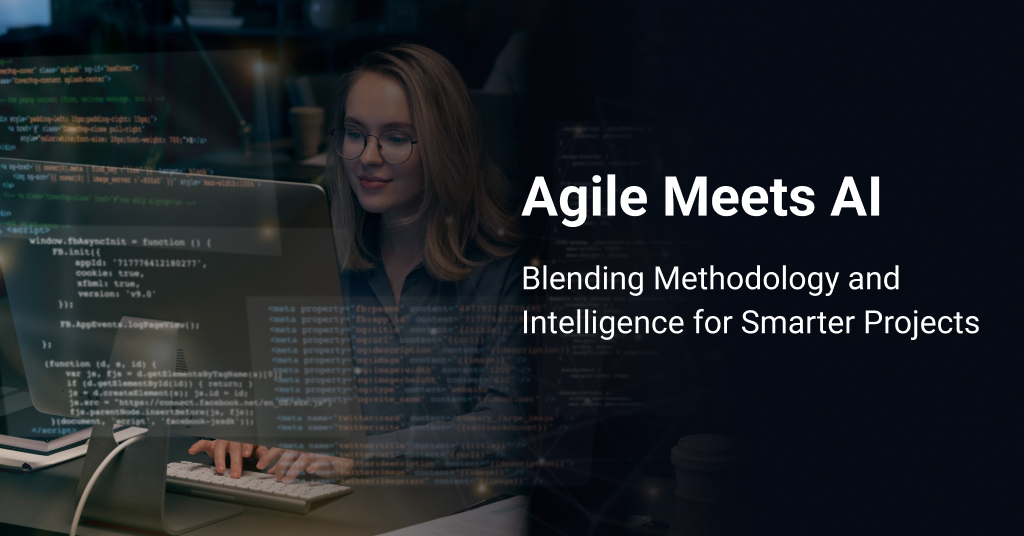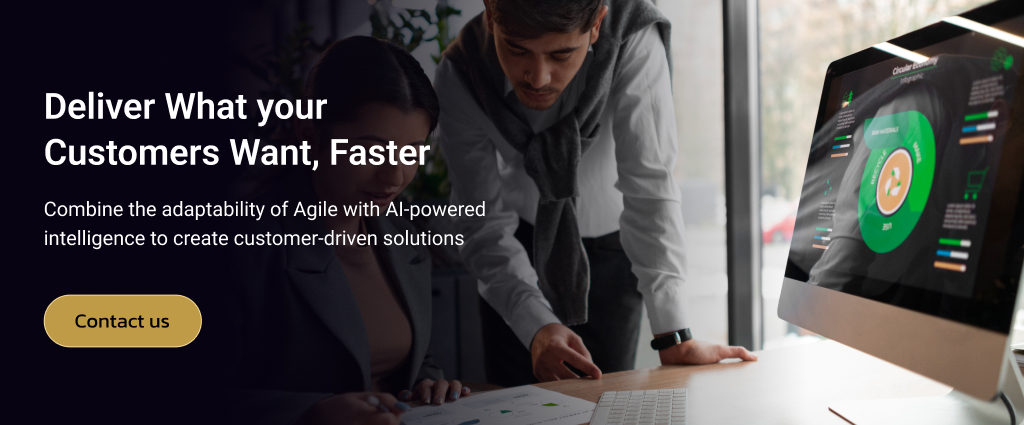
Agility has always been the heartbeat of successful software development, but what happens when you infuse it with the cognitive power of Artificial Intelligence? You get a paradigm shift—AI for Agile project management—a fusion that’s not just changing the game but rewriting its rules. This powerful combination enables teams to move beyond reactive workflows into predictive insights, intelligent automation, and seamless collaboration.
What is Agile?
At its core, Agile is a mindset—a framework built for adaptability, collaboration, and continuous delivery. It abandons rigid, linear processes in favor of iterative progress, enabling teams to respond dynamically to changing requirements. By fostering frequent feedback and incremental improvements, Agile methodologies like Scrum and Kanban help teams deliver results that matter, faster and more effectively.
The Rise of AI in Software Development
AI has transformed how we develop software, bringing unparalleled speed and precision to every stage of the process. Beyond automating repetitive tasks, AI acts as a strategic ally, analyzing complex datasets, detecting patterns, and offering actionable recommendations. In Agile workflows, it translates sprint data into foresight, aligns resources with priorities, and turns user feedback into actionable insights. AI doesn’t just support development—it supercharges it.
Why Combining AI and Agile is a Game-Changer
The integration of AI and Agile represents the next evolutionary leap in project management:
- Sharper Decision-Making: AI provides real-time, data-backed insights for sprint planning, backlog prioritization, and risk mitigation.
- Streamlined Processes: Automation of routine tasks accelerates delivery cycles, freeing teams to focus on innovation.
- Predictive Intelligence: AI anticipates roadblocks, optimizes resource allocation, and enhances overall efficiency.
- Customer-Centric Development: AI processes vast amounts of user feedback, enabling teams to build features that resonate.
The Synergy of AI and Agile Methodologies
By integrating Artificial Intelligence into Agile methodologies, teams can unlock unprecedented levels of efficiency, creativity, and collaboration. This synergy isn’t about replacing human ingenuity but enhancing it, enabling teams to focus on solving complex challenges while AI handles the tedious, data-intensive aspects of development. Here’s how this powerful combination transforms Agile practices:
Automation: Reducing Repetition, Increasing Creativity
Automation has always been a cornerstone of efficiency, but leveraging AI in Agile methodology takes it to a new level. AI-powered tools automate repetitive tasks such as code reviews, testing, and deployment, ensuring teams spend less time on routine chores and more on creative problem-solving.
- Intelligent Testing: AI-driven test automation tools identify errors faster, improve test coverage, and provide actionable insights without human intervention.
- Streamlined Deployment: Continuous Integration/Continuous Deployment (CI/CD) pipelines enhanced by AI reduce manual effort and accelerate delivery cycles.
- Enhanced Focus: By eliminating time-consuming processes, teams can channel their creativity into innovative features and robust architectures.
In this ecosystem, creativity thrives because the gruntwork is seamlessly handled by intelligent automation, giving teams the bandwidth to innovate.
Data-Driven Decision-Making for Agile Teams
Modern Agile development with AI relies heavily on data to inform decisions and optimize outcomes. AI transforms raw data into actionable insights, enabling teams to make more informed, confident decisions.
- Sprint Planning Precision: AI analyzes past performance metrics, like velocity and cycle times, to recommend accurate sprint goals and resource allocation.
- Backlog Prioritization: Machine learning models evaluate customer feedback, user behavior, and market trends to prioritize high-impact tasks.
- Proactive Risk Management: Predictive analytics identify potential bottlenecks and risks, giving teams the ability to address issues before they escalate.
By leveraging AI in Agile methodology, decision-making becomes smarter, faster, and more aligned with organizational goals. Data isn’t just a tool—it’s a competitive advantage.
Collaboration Redefined with AI
Collaboration is at the heart of Agile, and AI takes it to the next level by breaking down silos, enhancing communication, and supporting distributed teams.
- AI-Powered Communication Tools: Virtual assistants and chatbots provide real-time updates, reminders, and responses to common queries, ensuring everyone stays informed and aligned.
- Sentiment Analysis: AI can gauge team morale and identify early signs of burnout or conflict, helping leaders address issues proactively.
- Seamless Integration Across Teams: AI-powered platforms like JIRA and Trello automate task assignments and monitor workloads, ensuring equitable distribution and better synergy.
This redefinition of collaboration ensures that Agile teams remain cohesive and productive, even in complex or remote working environments.
Challenges and Solutions in AI-Agile Integration
| Challenge | Description | Solution | Examples |
|---|---|---|---|
| Ensuring Data Quality and Governance | AI requires high-quality, relevant, and unbiased data to provide accurate insights. Inconsistent or poor-quality data leads to flawed predictions and decisions. | Implement robust data governance policies, ensure regular data cleansing, and assign dedicated data stewards to maintain quality. Leverage tools for anomaly detection in datasets. | Netflix employs AI for personalized recommendations, backed by robust data governance and cleansing processes to ensure accurate viewer preferences. |
| Overcoming Skill Gaps: Training and Upskilling | Teams may lack the technical expertise to operate AI tools effectively or analyze outputs. | Conduct workshops and training programs to build AI knowledge within Agile teams. Partner with AI specialists or consultants for complex tasks. | Google introduced internal training programs like “AI Crash Course” to upskill employees, ensuring they could leverage AI effectively across diverse projects. |
| Addressing Ethical AI Concerns: Bias and Fairness | AI systems may inadvertently propagate biases from training data, resulting in unfair or unethical outcomes. | Use ethical AI frameworks and algorithms that actively detect and mitigate biases. Promote transparency by documenting how AI models are trained and validated. | IBM’s AI Fairness 360 toolkit helps businesses identify and mitigate bias in AI models, ensuring fairness in applications like recruitment and customer segmentation. |
| Aligning AI with Existing Agile Tools | Integrating AI with Agile project management tools like JIRA or Trello can disrupt workflows or require significant adjustments. | Select AI solutions that seamlessly integrate with existing Agile tools. Introduce phased implementation to minimize disruption and provide training for smooth adoption. | Atlassian (creator of JIRA) partnered with machine learning platforms to enable smarter backlog prioritization directly within Agile workflows. |
Benefits of AI-Agile Integration
The integration of Agile and AI solutions for businesses is transforming project management by streamlining workflows, enhancing decision-making, and delivering better customer experiences. By combining the adaptability of Agile methodologies with the computational power of Artificial Intelligence, businesses can optimize development cycles and achieve outcomes that are faster, smarter, and more customer-focused.
Here’s how:
1. Faster Sprint Planning with Predictive Analytics
One of the most time-consuming aspects of Agile project management is sprint planning, where teams prioritize tasks and allocate resources. With AI-driven predictive analytics, businesses can significantly accelerate this process.
- How It Works: AI analyzes historical sprint data, team velocity, and past performance metrics to recommend optimal sprint goals and timelines.
- Real-World Value: Predictive analytics ensures that teams focus on achievable objectives, reducing missed deadlines and rework.
- Example: Spotify uses AI to analyze developer productivity and sprint outcomes, enabling faster sprint planning and more accurate resource allocation for feature rollouts.
2. Intelligent Backlog Prioritization Based on User Behavior
Backlogs often contain numerous tasks and features, making prioritization a challenge. AI simplifies this by analyzing user behavior, market trends, and customer feedback to identify high-impact items.
- How It Works: Machine learning algorithms process data such as app usage patterns, click-through rates, and customer support tickets to rank backlog items by importance.
- Real-World Value: Agile and AI solutions for businesses ensure that teams focus on delivering features that users truly value, increasing product success rates.
- Example: Amazon leverages AI to prioritize its backlog by analyzing real-time customer purchasing behavior and feedback, ensuring product updates align with user needs.
3. Proactive Risk Management with Machine Learning
Risks such as resource bottlenecks, timeline slippages, or technical failures can derail projects. AI’s ability to predict risks early helps teams proactively mitigate them.
- How It Works: Machine learning models analyze factors like workload distribution, task dependencies, and historical project data to flag potential risks.
- Real-World Value: Teams can address risks before they escalate, maintaining project timelines and quality.
- Example: Microsoft employs machine learning algorithms within its Azure DevOps platform to analyze pipeline metrics and detect patterns indicative of resource constraints or potential delays. This helps development teams proactively reallocate resources and adjust timelines to avoid bottlenecks.
4. Enhanced Customer Feedback Analysis Using NLP
Understanding customer feedback is crucial for creating products that meet user expectations. Natural Language Processing (NLP) enables teams to process and analyze vast amounts of feedback effectively.
- How It Works: NLP algorithms extract insights from customer reviews, surveys, and support interactions, identifying common pain points and feature requests.
- Real-World Value: Agile teams can incorporate actionable insights into user stories, ensuring development aligns with customer needs.
- Example: Slack uses NLP to analyze user feedback, enabling the Agile team to prioritize updates that enhance collaboration features based on real-time user sentiments.
Emerging Technologies Shaping AI-Agile
AI development services are rapidly advancing, introducing innovative technologies that redefine how Agile teams operate. These emerging solutions streamline workflows, enhance collaboration, and boost productivity. Here are the key technologies driving the evolution of AI-Agile integration:
AIOps: Transforming DevOps
Artificial Intelligence for IT Operations (AIOps) helping DevOps by automating routine tasks like anomaly detection, root cause analysis, and system monitoring.
- How It Helps: AIOps minimizes downtime and enhances system performance by providing real-time insights and automated resolutions.
- Example: Companies like Adobe use AIOps to maintain seamless CI/CD pipelines, enabling faster, error-free software delivery.
NLP-Powered Story Creation
Natural Language Processing (NLP) simplifies the creation of user stories by analyzing customer feedback, support tickets, and market data.
- How It Helps: Agile teams gain actionable insights from large datasets, translating them into precise and impactful user stories.
- Example: Zendesk integrates NLP tools to help Agile teams extract meaningful user feedback, driving product improvements aligned with customer needs.
Automated Code Generation and Refactoring
AI-driven tools can write, refactor, and optimize code, reducing manual effort and errors.
- How It Helps: Developers focus on high-value tasks while AI ensures cleaner, more efficient codebases.
- Example: GitHub Copilot, powered by OpenAI, assists developers by auto-generating code snippets, saving time and effort during sprints.
Intelligent Virtual Workspaces for Hybrid Teams
AI development services are enabling smart virtual workspaces that foster collaboration across distributed teams.
- How It Helps: These platforms provide real-time updates, task tracking, and sentiment analysis to keep teams aligned and engaged.
- Example: Microsoft Teams uses AI to enhance hybrid collaboration with features like real-time transcription and intelligent task reminders.
Addressing Gaps and Future Trends in AI-Agile Integration
As AI development services continue to enhance Agile practices, addressing existing gaps and preparing for emerging trends is critical for businesses to maximize their potential. Ensuring inclusivity, simplifying integration, and reimagining team structures are key steps in creating a future-ready development process.
Inclusive and Accessible AI-Agile Tools
AI tools must cater to diverse teams and business needs, ensuring accessibility for all users regardless of technical expertise. Inclusivity is essential to leverage the full potential of AI in Agile environments.
- Bridging Accessibility Gaps: AI development services should focus on user-friendly interfaces, multilingual support, and voice-guided commands to accommodate a broader audience.
- Promoting Diverse Data: Ensuring AI systems are trained on diverse datasets helps mitigate biases, enabling fairer decision-making.
- Example: Salesforce Einstein incorporates intuitive dashboards and AI-driven insights to empower both technical and non-technical teams, making data accessible and actionable for all.
Strategies for Seamless AI Integration
Integrating AI into Agile workflows can be challenging without the right strategies. Streamlined processes and gradual adoption are crucial for minimizing disruption.
- Phased Implementation: Begin with pilot projects to test AI tools in isolated workflows before scaling across teams.
- Upskilling Teams: Provide training sessions and resources to ensure Agile teams can effectively utilize AI-driven tools.
- Ensuring Tool Compatibility: Prioritize AI development services that align with existing project management platforms like JIRA and Trello.
- Example: Atlassian’s integration of AI-powered recommendations for JIRA allows Agile teams to automate task prioritization without overhauling their workflows.
Reshaping Teams and Development Cycles
AI is redefining how Agile teams collaborate and deliver value, shifting traditional roles and processes toward a more data-driven approach.
- Dynamic Team Roles: With AI automating routine tasks, team members can take on more strategic roles, focusing on innovation and user-centric design.
- Shorter Iterations: AI-powered predictive analytics enable faster sprint planning and execution, reducing the time required for development cycles.
- Hybrid Collaboration Models: AI enhances communication across distributed teams, making hybrid workspaces more efficient and aligned.
- Example: Companies like Spotify leverage AI-driven tools to optimize sprint planning and resource allocation, fostering efficient hybrid teamwork.
Conclusion
AI is no longer an optional enhancement for Agile—it’s a fundamental driver. By integrating AI into Agile workflows, businesses can benefit from agility, efficiency, and innovation. The synergy between these two forces enables smarter decision-making, seamless automation, and user-focused development, setting the stage for a bright future of software delivery.
To fully leverage this potential, it’s crucial to adopt a strategic approach:
- Start Small, Scale Strategically: Begin with focused AI integrations in specific Agile processes to minimize disruption.
- Build Expertise: Hire AI developers with a deep understanding of Agile principles to craft tailored, effective solutions.
- Prioritize Collaboration: Use AI tools that enhance team communication and adaptability, even in hybrid or distributed setups.
Hire AI developers and use the latest tools to make this transformation a reality. By doing so, businesses can ensure they stay competitive, responsive, and ready to meet the demands of an ever-evolving market.






